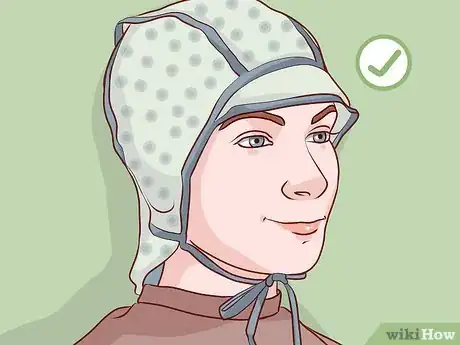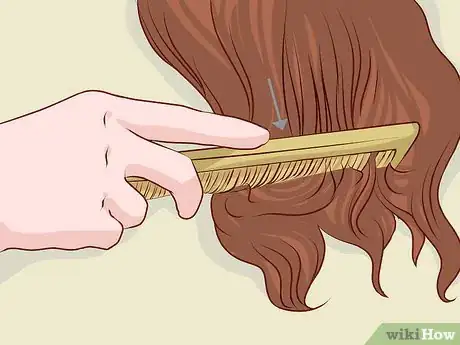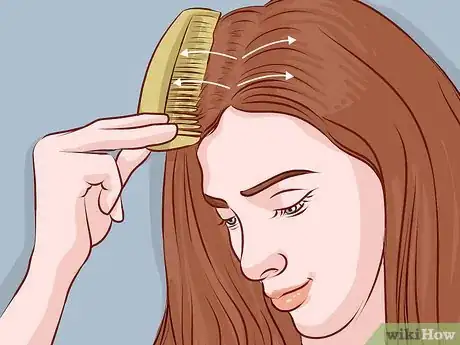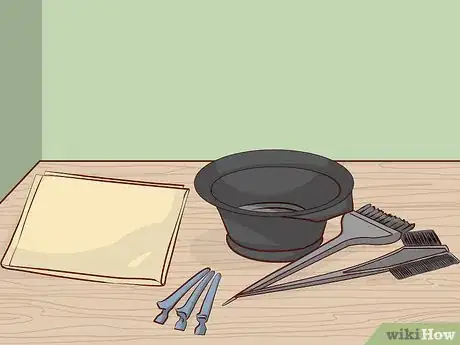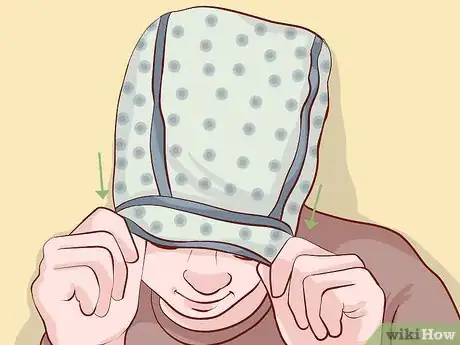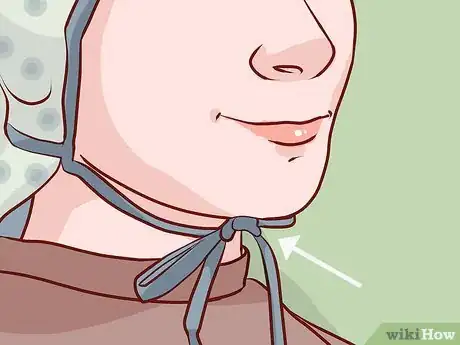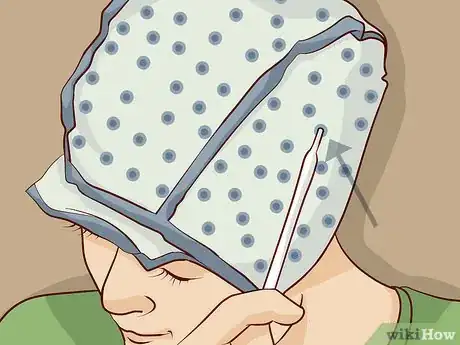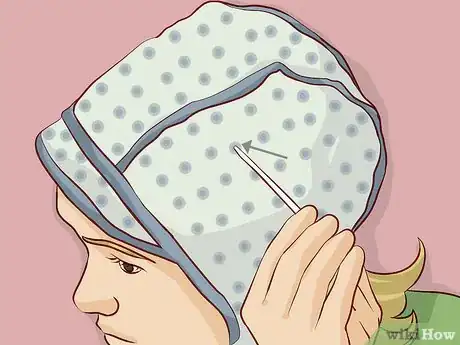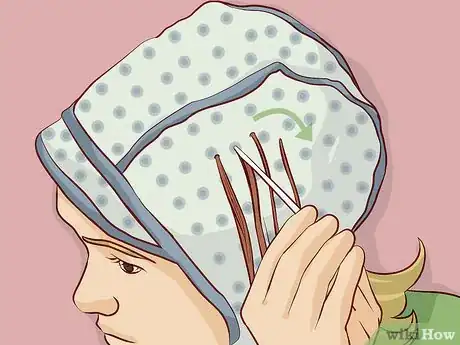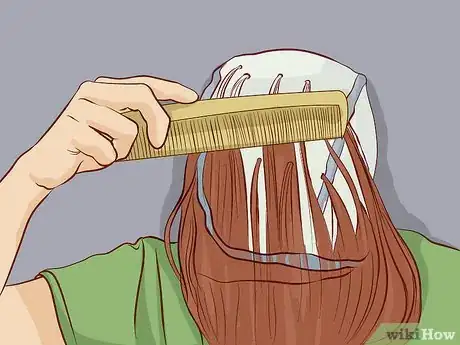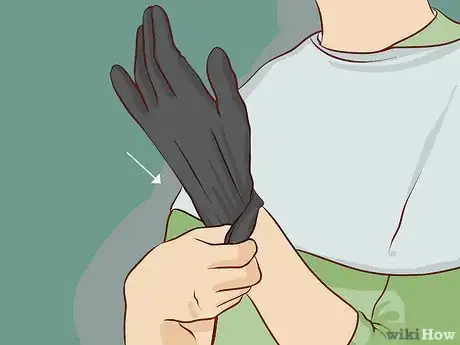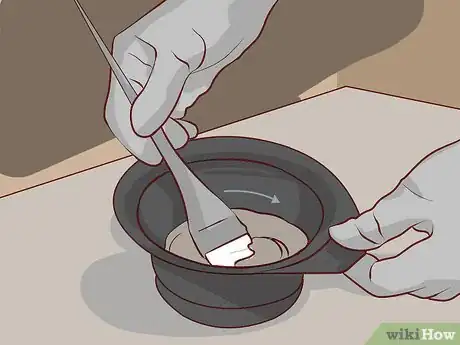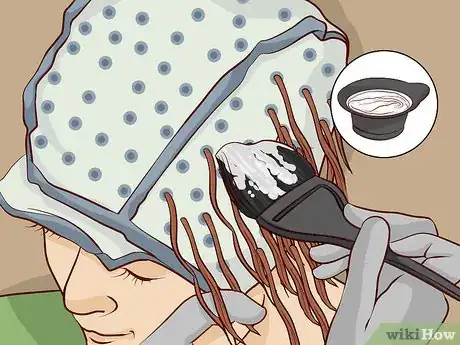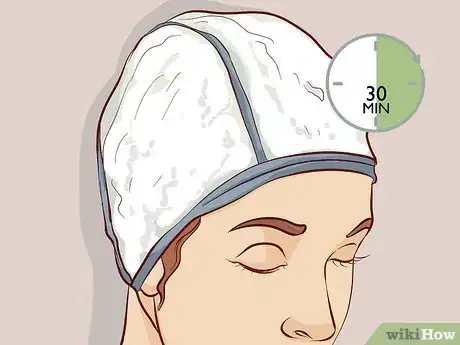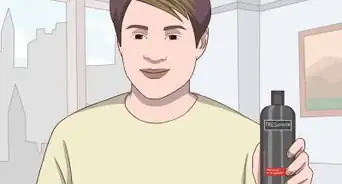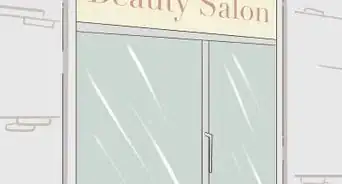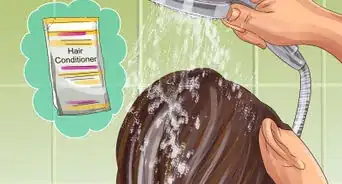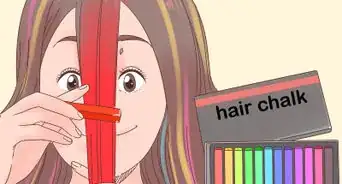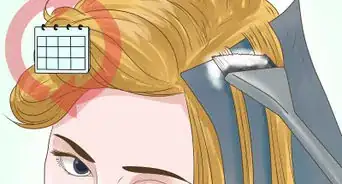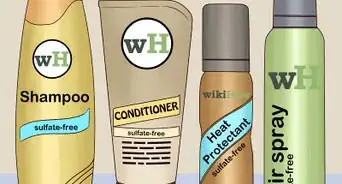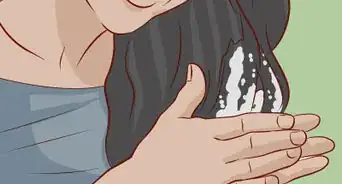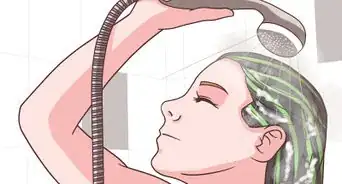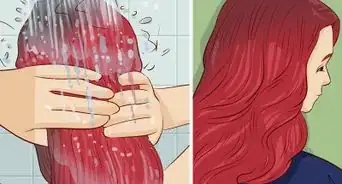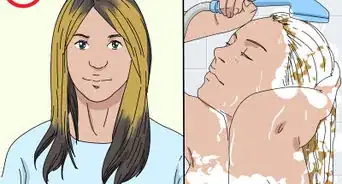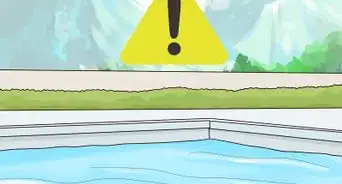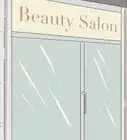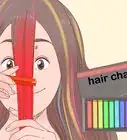This article was co-authored by Ashley Adams and by wikiHow staff writer, Amber Crain. Ashley Adams is a Licensed Cosmetologist and Hair Stylist in Illinois. She completed her Cosmetology education at John Amico School of Hair Design in 2016.
This article has been viewed 211,366 times.
Highlighting caps are easy to use and can help you achieve salon-quality highlights at home for a fraction of the cost. Start with dry hair and comb through it thoroughly to get rid of any tangles. Then, just pull the highlighting cap onto your head and use the highlighting needle to pull small sections of hair through the perforated holes on the cap. How much hair you pull through the cap depends on what kind of look you want to achieve! If you're looking for all the supplies you might need to do this at home, you can get a kit with everything you need on Amazon here.
Steps
Preparing Your Hair
-
1Use the highlighting cap technique on short to medium hair. Caps work best on short or medium length hair, and they're particularly effective when used on straight hair and layered hairstyles. Long hair tends to get tangled as it’s being pulled through the cap, which can be painful and result in very uneven highlights. That being said, if your hair is on the longer side, you may want to consider having your highlights done by a professional.[1]
- Curly hair also tends to get tangled and can be difficult to pull through the holes.
- If you have super thick hair, keep in mind that the process might take a while if you want all-over highlights.
-
2Detangle your dry hair thoroughly with a wide-toothed comb. Start at your ends and work the comb up to the roots of your hair, removing all knots and tangles. Tangling and snags can be painful to deal with when you're working with a cap and you could end up with patchy, irregular highlights. Tangle-free hair is easier to pull through and makes the process far more pleasant.[2]
- If your hair is coarse or prone to tangling, mist a light layer of detangler spray on your hair after you comb it out.
Advertisement -
3Part your hair down the middle and smooth it down. Place the end of a rattail comb at the center of your hairline, right above your forehead. Use the tip of the comb to draw a straight line down the middle of your head, starting at your forehead and stopping at your crown. Then, comb down each side so that everything is smooth.[3]
- The "crown" is located at the top of your head, right before the skull starts to curve downward.
- Center parting will help ensure an even distribution of highlights.
-
4Decide where you want your highlights to appear. Examine your hair before you put on the cap to determine where you want to place the highlights and how drastic you want them to be. Figuring that out ahead of time takes all the guesswork out of the process once the cap is on your head![4]
- For example, you might want face-framing highlights with additional highlights at the crown of your head.
- If you want all-over highlights, consider enlisting a friend to help you reach the hair on the back of your head. All-over highlights are also time-consuming, so a helper can significantly speed up the process.[5]
Organizing Your Supplies and Securing the Cap
-
1Set up your bleaching tools before you get started. The highlighting process will be much smoother if you lay all your tools and supplies out on your workspace. Aside from the highlighting cap, you’ll need a highlighting needle, latex gloves, bleach powder, developer, a bowl, and a tint brush. You can pick these items up at any beauty supply store, or on Amazon here.[6]
- Highlighting needles come in a range of sizes, depending on big you want your streaks. The bigger the needle, the more hair you can pull through each hole in the cap.[7]
- Look for a highlighting kit at the beauty supply store, especially if this is your first time. That way, everything you need is in the kit!
-
2Choose a highlighting cap with clearly marked holes. Clearly marked perforations will make it a lot easier for you to figure out where to pull the hair through and ensure that you end up with evenly spaced highlights. Some caps have specific patterns or numbered or color-coded holes to help you achieve the effect you want. You can even buy caps to help you achieve specific results.[8]
- For example, if you want large, bold highlights, look for “streaking” kits. The holes on the cap will be spaced in a particular way and the kit will include a bigger highlighting needle.
-
3Pull the highlighting cap onto your head so that it fits snugly. Hold the cap with both hands and pull it over your head. Keep pulling the cap down until it fits snugly against your skull. A snug fit ensures that there won’t be a big gap between your roots and the cap. You want to get the bleach as close to your roots as possible.[9]
- You don’t need to pull the lengths of your hair up into the cap—they should be sticking out of the bottom of the cap.[10]
- If you have hair that is thick or voluminous, like curly or textured hair, it's best to get a blow out before you try to use a highlighting cap. This will smooth down your hair and help you put the cap over your head. Additionally, it'll be easier to pull your hair through the holes in the cap.
-
4Fasten the straps under your chin to secure the cap in place. If there is a strap hanging from the cap on each side of your head, grab the straps and tie them into a snug bow underneath your chin. Don’t tie the straps so tight that it hurts, but it’s important to secure them snugly so the cap stays firmly in place during the highlighting process.[11]
- If the cap shifts around or gets loose when you’re highlighting your hair, you could end up with patchy, uneven results.
Pulling Strands with a Highlighting Needle
-
1Insert the highlighting needle into the first hole. Choose a hole close somewhere along your hairline as your starting point. Hold the highlighting needle as flat as possible on the outside of the cap and keep the hook pointed upward as you insert it into the perforated hole. Push the needle until the hooked end is resting gently against your scalp.[12]
- Make sure you're poking the needle through the perforation from the outside of the cap to reach your hair underneath.
- Starting at your front hairline will help you stay organized and allow you to work systematically. If your placement gets erratic, your results will probably end up looking blotchy.[13]
-
2Hook the tool around a small amount of your hair. Once the hooked end of the needle is resting against your scalp, all you need to do is angle it slightly to one side to hook a tiny section of hair. You shouldn’t need to work hard or dig in the needle to hook the hair! If you mess up, or if you don’t hook the amount of hair you want, just pull the needle out and start again.
- The more hair you pull through, the bigger and more prominent your highlights will be.
- This process can be a little painful, so be as gentle as possible. Typically, smaller holes and smaller needles are more painful.
-
3Use the needle to pull the hooked section of hair through the hole. Pull the needle away from your head so the hooked hair comes through the perforation. Keep pulling until the entire section of hair is neatly hanging outside of the hole in the cap, from root to tip.[14]
- If any hairs got snagged on the hole, hook them and pull them out to be with the rest of the section.
- Work slowly and steadily. If you rush, the hair might get uneven or tangled.
-
4Continue hooking and pulling hair through the holes strategically. Pulling hair out of every hole will give you the most highlights. You can also follow a particular pattern, like skipping every other hole, to achieve more space between your highlights. Work from the hairline to the crown, then move to the next section at the hairline and continue pulling hair using the same pattern.[15]
- Your cap will probably have circles or numbers to make strategic placement super easy. Just be sure to stay consistent as you work!
- For example, if you want face-framing highlights, pull hair out of every other hole along your hairline. For a more subtle look, pull hair from every third hole instead. If you want bold, prominent highlights, pull hair through every hole along your hairline.
-
5Comb through the pulled strands of hair. After you’ve pulled out all of the hair you want to highlight, gently comb the sections from root to tip with a comb. That way, you can remove any tangles that formed during the process and fix any snagged hairs that are stuck around the perforations.[16]
Applying the Bleach
-
1Pull on latex gloves and protect your shoulders with an old towel. Gloves will protect your hands and fingers from prolonged contact with the bleach solution, which can burn your skin. Bleach can also stain and damage surfaces, so pull an old towel around your shoulders.[17]
- Consider lining your work surface with plastic garbage bags, newspaper, or towels to protect it.
-
2Mix the bleach powder and developer according to the directions. Products will vary, but typically this involves pouring bleach powder and developer into a bowl and stirring them together with a plastic spoon or spatula. Follow the instructions provided by your specific product.
-
3Paint the bleach mixture onto each strand with a tint brush. Dip the tint brush into the bowl and pick up a small amount of the bleach mixture. Then, starting at the roots and working your way to the tips, paint the bleach mixture onto each strand of hair.[18]
- Be sure to saturate every strand thoroughly and evenly.
- It may be helpful to clip your hair into sections and work on 1 section at a time. While you aren't working with a full head of hair, it can still be difficult to apply the bleach to each strand evenly.
-
4Let your hair process according to the product’s instructions. How long you let your hair process depends on the product and the shade you’re going for, but it’s usually around 20-30 minutes. It can help to set a timer, just in case you lose track of time!
- The processing time typically depends on the volume of developer you use, as well as how light you want your highlights. Lower volume developers usually take longer to process. Similarly, you may need to leave the bleach on your hair longer for lighter highlights.
- Never leave bleach mixture on your hair for longer than 1 hour.
-
5Rinse the highlighted streaks thoroughly with cool water. Leave the cap on and rinse the bleach solution out of the strands that are pulled through. Some products may direct you to shampoo the strands to remove the bleach mixture. Be sure to follow the package directions for your product.[19]
- Using lukewarm water is also fine, but definitely do not use hot water to rinse bleach out. Your hair is delicate after bleaching, and hot water can weaken it even more.
- Rinsing with cold water seals the hair cuticle. Most stylists agree that this is the best thing to do right after bleaching.
- If your product says to use shampoo during the rinse, it's best to use a mild, sulfate-free shampoo.
-
6Remove the cap and apply a deep conditioner all over your hair. Once the bleach is rinsed out, you can take off the cap and wet all of your hair. Apply a deep conditioner all over your hair and let it sit for 3 minutes before rinsing it out thoroughly using cool water.[20]
- Bleaching is a harsh process because the strong chemicals dry and weaken the hair cuticle quite a bit. Using a deep conditioner right after bleaching gives your hair a much-needed dose of nourishing hydration.
Things You’ll Need
- Rattail comb
- Wide-toothed comb
- Highlighting cap
- Highlighting needle
- Bleach mixture
- Tint brush
- Towel
- Bowl
- Latex gloves
- Deep conditioner
References
- ↑ https://www.hairfinder.com/tips/highlighting-cap.htm
- ↑ https://www.hairfinder.com/tips/highlighting-cap.htm
- ↑ http://missysue.com/2012/10/8-tips-for-highlighting-your-hair-at/
- ↑ http://missysue.com/2012/10/8-tips-for-highlighting-your-hair-at/
- ↑ https://www.hairfinder.com/tips/highlighting-cap2.htm
- ↑ https://www.haircrazy.com/articles/dyeing-techniques/streaks-highlights/
- ↑ https://www.hairfinder.com/tips/highlighting-cap.htm
- ↑ https://www.hairfinder.com/tips/highlighting-cap.htm
- ↑ http://missysue.com/2012/10/8-tips-for-highlighting-your-hair-at/
- ↑ http://www.schwarzkopf.com/en/hair-color/streaks/home-made-streaks.html
- ↑ http://missysue.com/2012/10/8-tips-for-highlighting-your-hair-at/
- ↑ http://www.schwarzkopf.com/en/hair-color/streaks/home-made-streaks.html
- ↑ https://www.hairfinder.com/tips/highlighting-cap.htm
- ↑ http://missysue.com/2012/10/8-tips-for-highlighting-your-hair-at/
- ↑ http://missysue.com/2012/10/8-tips-for-highlighting-your-hair-at/
- ↑ http://missysue.com/2012/10/8-tips-for-highlighting-your-hair-at/
- ↑ http://missysue.com/2012/10/8-tips-for-highlighting-your-hair-at/
- ↑ https://www.hairfinder.com/tips/highlighting-cap.htm
- ↑ http://www.schwarzkopf.com/en/hair-color/streaks/home-made-streaks.html
- ↑ http://www.schwarzkopf.com/en/hair-color/streaks/home-made-streaks.html
